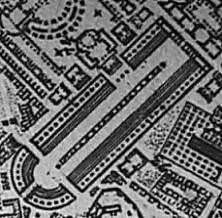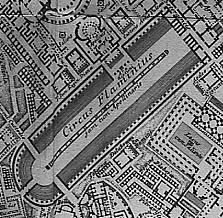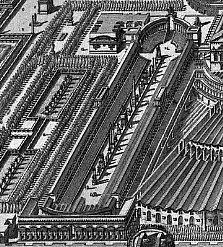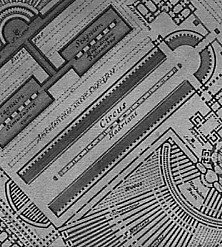homo ludens and the Ichnographia
1999.07.14
There are certain passages within Homo Ludens that relate to Piranesi's "play" of the Ichnographia Campus Martius, especially with regard to reenactment, the Scenographia, and the double theater. There are also connections between ritual and play that relate to the Triumphal Way.
Pagan - Christian - Triumphal Way
3123h
3123i
3123j
3123k
1999.11.21
The City of Collective Memory
2000.03.30
Piranesi also borrowed the devices of Baroque scenographers, heightening the impact of his fantastical compositions of Rome by twisting and turning their viewpoints, creating a confused montage of fragments and spaces, of exaggerated proportions and depth. If Greek architecture was the epitome of purity and restraint, then Roman architecture, so Piranesi surmised, had been erected by plunderers and despoilers, and its compositional forms were not only eroded by time but compromised by choice. Roman ruins were exceptions to the ideals of purity, existing beyond any order that classicists might impose. Their mysterious allure resided instead within irrational and archaic realms. So Piranesi, a bricoleur in search of new orders and new inventions, turned away from those who poked around for the origins of architecture among its ornaments and stones and reached beyond the contemporary zeal for restoration. He moved instead into an arbitrary, utopian, and entirely imaginary sphere of subjective experience. Fantasy holds an essential role in any "analogous city" view, for fantasy is the mediator between an archeologist's mind bent on exploring roots and remnants of antiquity and a creative imagination that quotes and remembers only arbitrary and unrelated fragments and traces. Through incongruous recombinations and imaginary superimpositions, Piranesi diverted architectural symbols from their original meaning. He played an enigmatic game of architectural writing in which reality and the imaginary are confused.
M. Christian Boyer, The City of Collective Memory : its historical imagry and architectural entertainments (Cambridge, MA: The MIT Press, 1994), pp. 176-8.
more on language
2000.12.13
/reenactionary
2001.08.02
2. the crucifixion of St. Peter - the inversion of Christ's crucifixion; Porticus Neroniani as inversion of St. Peter's Basilica; is this the origin of Piranesi's overall inversionary reenactment theme? (It certainly could be.); this could certainly lead to the double theater of St. Peter's Square; the double inverted theaters of the Ichnographia; then the Bernini double play; the Baroque ending (for sure).
back to the Campo Marzio
2001.09.08 16:50
Hello John,
...getting back to the two states of the Ichnographia, here are some further thoughts and questions:
1. I believe the first state is the plan as it is NOT published in books today. If you look at the smaller and earlier plans of the Campo Marzio within the plates prior to the Ichnographia, you will see earlier plans of the Circus Flaminius the same as the Circus Flaminus plan within the first state Ichnographia. Furthermore, the aerial view the Circus Hadriani within the frontispiece corresponds in plan with the first state Ichnographia.
 
 
2. I think the circus delineations of the second state (which are all virtually identical to each other) are in fact delineations based on the Circus of Maxentius (rather than the Circus Maximus). This is somewhat significant in that (according to my research and interpretation of the Ichnographia as a double narrative relating Rome's inversion from pagan city to Christian city) Maxentius is exactly the ruler of Rome immediately prior to Constantine's Chistian efforts.
3. ...now knowledgable of the practice of damnatio memoriae, I wonder if Piranesi purposefully 'erased' portions of the Ichnographia as a reenactment of the damnatio memoriae practice, and, like some extant examples of dm inscriptions, if he then purposefully followed up with a palimpsest (of another plan) over the erasure.
4. I realized that I have yet to see an actual print version of the second state of the Ichnographia. All I've ever seen is an actual first state (1761) version. Do you know if you've seen an actual eighteenth cent. print version of the second state? Moreover, did you happen to make a trip to Rome to see which state the actual engraved plates are in? It is the current state of the plates that would surely identify the second state (that is, unless someone long ago altered a reproduction, and it happens to be an altered reproduction that's been printed in books all these years).
5. I also believe that it was indeed Piranesi that made the changes. My main reasoning here is that Piranesi was very likely the only person that could have made the changes with such dexterity.
As to Tafuri, I have documented so many cases within the Ichnographia that carried explicit meaning and message on Piranesi's part, that all of Tafuri's theorizing that the Ichnographia is indicative of and/or percursor to the modern meaninglessness of architectural form is plainly and emphatically wrong. What Tafuri obviouly never did, but definitely should have done, is to translate all the Latin labels that Piranesi applies to virtually all the plans of the Ichnographia. It is only through reading the labels and the planimetrics in combination that the full meaning of Piranesi's Campo Marzio comes through.
All the best,
Steve Lauf
| |
Piranesi's Continual Double Theaters
2001.11.26
The subject of double theaters starts with Bernini's play--the Baroque ending for sure--and it is Piranesi that continues this Baroque design technique. Oddly, the double theater aspect of Piranesi's design methodology has yet to be recognized by designers or design theorists or critics.
A short list of Piranesian double theaters:
1. check for possible examples in the Prima Parte.
2. the two states of the Carceri.
3. Wilton-Ely's example of mirrored precedent for one of the Carceri.
4. the overall double--Pagan-Christian--narrative of the Ichnographia Campus Martius, with the Scenographia as the empty stage set.
5. the double directional Triumphal Way.
6. the axes of life and death.
7. the axes of love and war.
8. the Mars - St. Agnes axis.
9. the theatrics of satire--Horti Luciliani.
10. the (literal) double theaters-- Marcellus and Balbi.
11. the "circus act".
12. the back versus front of the altar.
13. the two sets of cochinae--is the snail its own double theater in that it self propagates, i.e., fulfills both sex roles individually? does this relate to the intercourse building?
14. the "rise and fall" (of Imperial Rome) as delineated by the two Busti Busti.
15. it seems a case could be made regarding the working together of two mediums-- plan delineations in combination with Latin labels.
not Tampa, Florida anymore
2002.01.10 00:40
I'm glad you found some useful information, and I hope it helps toward some resolution to how you see that reenactment (potentially) relates to predestination and psychology. I haven't been coming to reenactment from that angle, so I don't even understand exactly what you're seeing. (But that doesn't at all mean that I think what you're seeing is somehow wrong or misinterpreting.)
I'll try to briefly outline (reenact) how I came to see a strong relationship between reenactment and (some but certainly not all aspects of) design.
I began redrawing Piranesi's Campo Marzio plan with CAD in 1987. I've been fascinated with this plan since the late 1970's, and I saw the opportunity to utilize the automated drawing/drafting capabilities of CAD in (re)drawing all the complicated individual plans of the Campo Marzio, which comprise many repetitive units, and manipulating repetitive units is precisely one of the things CAD is very good at facilitating.
In the early 1990s I begin an intensive redrawing of the plan, and at the same time I became reacquainted with Susan Dixon, a friend from my college days who went on to get a Ph.D. in Art History, and her dissertation was on Piranesi's archaeological publications, of which the Il Campo Marzio is one. Together (via phone conversations) Susan and I begin speculating as to what the meaning of the Campo Marzio plan might be. Many theories were speculatively put forth, but reenactment was never one of them.
The second week of August 1997 I split my energies between doing research on the Campo Marzio and research on the philosophy of history as it might relate to my theory of chronosomatics. In Encyclopedia Britannica (edition 1969) under "Philosophy of History" there is a passage explaining Vico which, while reading it, made me think of Piranesi's Campo Marzio. There is also a list of 20th century philosophers of history and the titles of the works. Collingwood's The Idea of History is among these. I go to Barnes and Nobles that same day and buy Vico's New Science and Collingwood's The Idea of History. I read the passages in The Idea of History that deal with reenactment. It dawns on me that I've been doing a kind of reenactment by redrawing Piranesi's plan.
Thursday, September 4, 1997 (coincidentally the day architect Aldo Rossi died) I find Plattus's "Passages to the City: The Interpretive Function of the Roman Triumph" in Ritual (1983). I finish reading the essay Friday night. Saturday morning I watch Diana's funeral, and it quickly hits me that I am watching exactly what I just spent the last two nights reading about. Since Piranesi himself delineated the path of the Triumphal Way through his plan of the Campo Marzio, I begin to wonder whether Piranesi too was playing some kind of reenactment game in his redrawing of the large urban plan.
It is after this point that much of the prior ten year's work begins tightly piecing together, and the notion of reenactment also aids in better understanding what information I collected further in research.
For me, reenactment was a learning tool, albeit for the most part a tool I didn't even know I was using. For Piranesi, however, (and this is what I've come to understand) reenactment was a design tool, specifically an urban design tool, whereby he generated an entirely new rendition of Rome. A Rome, moreover, that is essentially a conglomeration of many specifically themed environments, i.e., themed environments that relate exactly the history of the very places where Piranesi positioned his new designs. This is why I say Piranesi's Campo Marzio is not a reconstruction, rather a reenactment. By all indications, Piranesi was very conscious of the play of degrees of separation that reenactments involve.
Piranesi also (re)designed the city of Rome as a double (history) theater, namely the double theater of Rome's Pagan and Christian existence.
Re: lack of life
2002.01.19 11:46
...to learn more of Honorius (the younger son of Theodosius who is now Emperor of the West) and his wife Maria. Honorius was the last ancient ruler to [re]build the walls of Rome (because of the "Gothic Wars" -- Christian "Goths" that is) and he also built an imperial mausoleum attached to the original Basilica of St. Peter's. Sometime in the 1500s the sarcophagus of Maria was discovered (very likely while the old basilica was being demolished to make way for the new/present one). The sarcophagus of Maria may well be the last substantial imperial artifact of (the city of) Rome, and after an illustrious title page and a frontispiece, it is an image of the sarcophagus of Maria that Piranesi uses to begin his Campo Marzio publication. In a most elegantly covert way, Piranesi began the 'history' of the Campo Marzio with what is really it's ending, and what is probably the world's greatest designed architectural inversionary double theater goes on from there.
It rocked Eisenman on his chair...
2007.11.09 10:56
Giovanni Battista Piranesi died today in 1778, on the feast of the dedication of the Basilica Constantiniani (known today as the Basilica of St. John Lateran), the first Christian basilica in Rome.
"Piranesi uses the Rome that was extent in the eighteenth century as a starting point, but that possesses no original value; it is merely a being in the present. From this existential moment of being, he takes buildings that existed in the first and second centuries, in Imperial Rome, and places them in the same framework of time and space as the eighteenth-century city."
--Peter Eisenman, "Notations of Affect. An Architecture of Memory" in Pathos, Affect, Gefühl (Berlin: Walter de Gruyter GmbH, 2004), pp.504-11.
If you actually study the Campo Marzio you'll find the starting point, framework and the millennium's worth of buildings that Piranesi utilized. First there are the altar and race course dedicated to Mars by Romulus in the mid-eighth century BC. Incidentally, this is how the Campo Marzio received its name--the fields of Mars. And to manifest the framework there is the last Imperial artifact of the Campo Marzio, the sepulcher of Empress Maria, wife of Honorius, from the early 5th century AD. Indeed the sarcophagus of Empress Maria holds a key position within the Il Campo Marzio publication. And to complete the framework, the last page of Il Campo Marzio depicts a double theater.
...and speaking of random tangents
2007.03.12 17:05
"In a sense Asimov, Heinlein, and the masters of American Science Fiction are not really writing of science at all . . . They're writing a kind of fantasy fiction about the future, closer to the Western and the Thriller, but it has nothing really to do with science . . . Freud pointed out that you have to distinguish between analytic activity. which by and large is what the sciences are, and synthetic activities which are what the arts are. The trouble with the Heinlein-Asimov type of Science Fiction is that it's completely synthetic. Freud also said that synthetic activities are a sign of immaturity, and I think that's where classical Science Fiction falls down."
--Ballard, Speculation, 1969.
Upon first reading this passage, thoughts of how Piranesi's Il Campo Marzio dell'Antica Roma and particularly the Ichnographia Campi Martii have been largely misinterpreted by 20th century architectural 'scholarship' came to mind. The synthetic quality of Piranesi's archaeology (before archaeology was formalized into a science) is all the critics/theoreticians saw, and they completely discounted the analytical aspect of Piranesi's archaeology. Basically, a non-analytical analysis resulted in a synthetic interpretation.
The wonderful thing about Il Campo Marzio dell'Antica Roma (including the Ichnographia Campus Martius) is that the distinction between the analytical and the synthetic is never manifest--the work seamlessly embodies both natures.
|